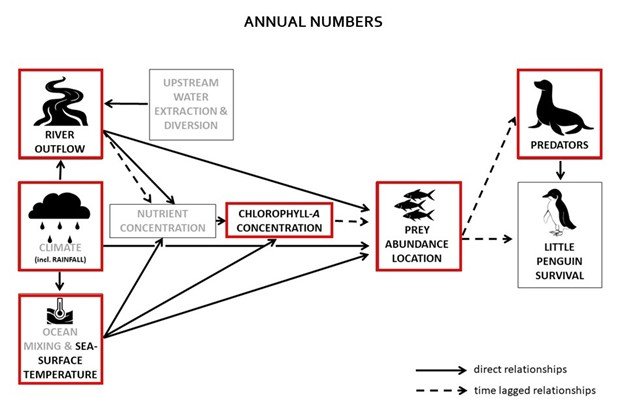Linking Little Penguin Movement to Murray River Outflow
First Little Penguin Track at Granite Island
Our first little penguin champion, “Jeffrey”, has shown some amazing movement patterns. He is a 1.4 kg (very plump) penguin who calls Granite Island Home. In September of this year we deployed our first satellite tag with “Jeffrey” with Flinders University Little Penguin Research Team. Amazingly he made daily trips out to the Murray River outflow and spent his time at sea where the Murray River outflow meets the Southern Ocean. He would return late at night each evening, except for a 3-day at sea trip that he did when the outflow moved further south. Our first series of tracks with Jeffrey shows the water flowing from the Murray River has an important place in his foraging and movement choices.
These are some maps showing Jeffrey’s movements. The first map shows his locations in relation to Granite Island, the Murray River mouth and Kangaroo Island at the bottom left of the image. The second image shows his movements over 12 days in relation to the plankton blooms and includes his 3 days at sea “expedition”. The green represents phytoplankton blooms (that stimulate the food chain) from the nutrient rich water flowing out of the Murray River mouth and mixing with the Southern Ocean.
Little Penguin satellite track in relation to the Murray River Outflow and Kangaroo Island in the lower left corner
12 days of “Jerreys” movements at sea and close to the murray river outflow (show in green)
What does the Murray River have to do with little penguins?
Little penguins are a key emblematic species in South Australian waters and are the smallest of penguin species. They reside as colonies on land, often in protected areas of rocky islands, and enter the ocean to feed and move in pursuit of small bait fish (their preferred prey). Unfortunately, several local populations, particularly on Granite Island, have experienced radical declines since the early 2000’s. Some, for example, have declined from over 1000 individuals in the 1990’s to only dozens. Recent work suggests a direct linkage between Murray River outflow and local little penguin population stability/growth. Nutrient pulses as freshwater meets the Southern Ocean stimulates the basal food chain (phyto/zoo plankton) creating localized hotspots of food availability for adult and young little penguins. Outflow from the Murray River all but ceased from 2000 to 2010 due to severe drought in central Australia with resultant decline in little penguin populations. Survivorship of young penguins is likely closely linked to the quality and resultant availability of small fish species, such as pilchards (which form a key component of the diet), that respond to these outflows.
See more detail in Diane’s paper in Frontiers "Combined Effects of Hydrological Drought and Reduced Food Availability on the Decline of the Little Penguins in South Australia” (frontiersin.org)
The Scientific Model For Penguin Survivorship
The scientific model for the penguin survivorship:
How do we track the little penguins?
In this study we are utilizing state of the art miniaturized streamlined satellite and GPS tracking tags that can be easily, temporarily and gently attached to the back feathers of suitably sized little penguins. These tags enable movement of penguins to be monitored as they come to the surface. Penguins often come to the surface of the water to rest when they are not pursuing bait fish and between dives. When they remain on the surface, tracking tags then emit a signal that provides a position in real-time and a “retrace of movement” from data download when the tags are recovered after the penguins return to land. Our study is aiming to identify linkages with the Murray River via short-medium term movement of little penguins.
Are there other examples of little penguin tracking studies?
Here’s an example of 24 hr. tracks of little penguins moving out to sea in New Zealand. Tags recorded a position every 1 minute. Each colour represents a different little penguins movement.
What does tracking tell us?
The little penguins’ movements tell us about their at-sea-behaviour, such as ocean habitat-use, range of daily foraging and how frequently they utilise the Murray River outflow. Little penguins often have several key modes of movement when at sea. These include, resting, moving and area-restricted foraging. We are particularly keen to understand these area-restricted foraging zones in relation to Murray River outflow. Little penguin movements can also be related to physical and environmental conditions. These factors include relating movement to patterns in coastal waters’ sea surface temperatures and chlorophyll-a concentrations alongside rainfall and freshwater river outflows that support various marine life. In fact several previous studies of little penguins in other locations have found their ocean habitat-use and foraging activity to be related to bathymetry, rainfall, outflow, plankton biomass, proximity to river mouth, water temperature, eddies, current outflow as well as fish biomass. So there does seem to be a common trend for little penguins in different places around the world, to have an important association with rivers and subsequent freshwater outflows!
Penguin tracking can also give us some insight into social behaviour amongst penguins when they are at sea.
Picture of at-sea feeding on fish and close to other little penguins, courtesy of Associate Professor Andre Chiaradia. These pictures were obtained via a small camera temporarily attached to the back feathers.









